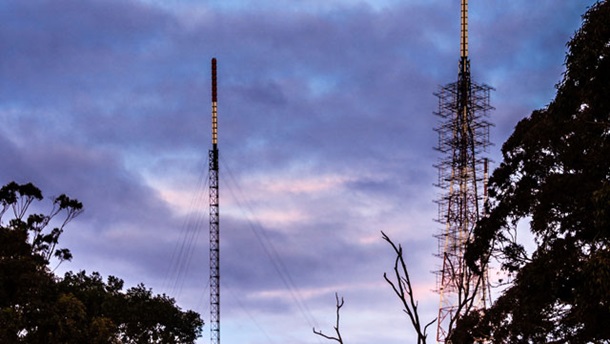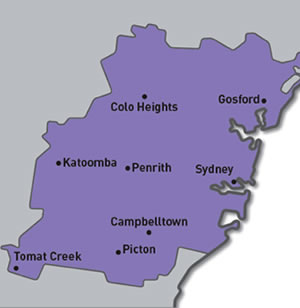November 2016.
Mobile broadband & TV reception: The link

With mobile broadband services a high priority for both communities and providers, the ACMA is aware of the rollout of a significant number of new base stations across Australia over the next few months. This will improve mobile coverage and enable high-capacity services, but there may be flow-on effects to TV reception in some areas.
While this is unlikely to affect most viewers, some people living near mobile base stations may experience reception difficulties following the rollout due to ‘receiver overload’. This is not a new problem and is an inherent risk whenever high-power radiocommunications services (such as mobile telephony base stations) are established in frequencies nearby to those used by TV services.
Will I be affected?
In general, TV reception should not be affected by the rollout of mobile telecommunication services, especially if your television receiving installation is optimised. Many mobile base stations have been operating across Australia for years without causing disruption to TV viewers.
However, if you live close to a new or existing mobile phone base station and experience a sudden change to your TV reception quality on all channels, then you may be affected by receiver overload. This is also more likely if one or more of the following apply:
- your area is covered by UHF, rather than VHF, television services
- your received television signal levels are low
- your TV antenna is directed towards the mobile base station
- your TV receive system uses sub-optimal antennas (such as inappropriate/legacy antenna configurations or antenna systems in poor condition)
- your antenna system uses a masthead or distribution amplifier (also known as a ‘signal booster’).
In these cases, you’ll be more likely to experience reception difficulties and may need to improve your receiving system to enable continued TV reception. Only a limited number of viewers should need to upgrade their equipment.
How can I prevent reception problems?
Making sure you’ve installed the most appropriate reception equipment will not only give you the best TV service, it will also lessen your chances of being adversely impacted by receiver overload.
The risk of receiver overload is higher if you use a masthead or distribution amplifier. In principle, you should only use a signal booster if you live in a marginal coverage area and it should be deployed with the minimum gain that provides adequate reception. In some instances, upgrading to a high-gain antenna may eliminate the need for an amplifier and significantly increase the reliability of your reception. Make sure you ask a competent antenna installer before removing the amplifier from your receiving antenna system.
Most areas where the new mobile base stations will be rolled out have adequate TV coverage. So if you’re able to receive adequate signal levels, don’t use a signal amplifier. Use of an amplifier will actually increase the susceptibility of your television receiving system to signal overload.
Remember to ask the experts!
Make sure you contact a reputable antenna installer to investigate your reception difficulties. The installer can determine whether these problems are caused by deficiencies in equipment, mobile broadband services or other potential sources of interference.
If the antenna installer determines that your TV reception may be affected by a mobile broadband base station, there’s some easy ways to fix the problem, including:
- installing a simple filter at the appropriate point in the receiving installation
- replacing the antenna with one that has the filter built in
- removing a signal booster if not needed
- relocating the antenna to a location less prone to picking up the mobile broadband signals.
April 2014.
Introducing FreeviewPlus
Freeview unveiled the key features for FreeviewPlus last month. It’s a new service that provides access to content and services from the free-to air networks.
At the core of FreeviewPlus is a free-to-air TV electronic program guide incorporating broadband-delivered services that will offer Australian consumers an unrivalled viewing experience.
As first announced in November last year, FreeviewPlus will deliver the most advanced, user-friendly free-to-air EPG experience, with catch-up services accessed from one place on TV screens for the first time.
“FreeviewPlus is one of the most important advances in free-to-air television in Australia since the introduction of digital TV,” Liz Ross, General Manager of Freeview, said.
“In just a few months, Australian TV viewers will be able to access and enjoy a very sophisticated and yet easy-to-use free-to-air TV service.”
FreeviewPlus will offer a range of new features including:
• A 7-day, easy-to-use EPG
• All available FTA catch-up TV through the TV screen and one EPG
• Highlights of the big shows today, on catch-up and in the future
• Ability to browse and search programs for the next 7 days
• A “Favourites” function with reminders
FreeviewPlus will be available through new connected receivers carrying the FreeviewPlus logo including panel TVs, set top boxes and recording devices.
Manufacturers will release a range of FreeviewPlus receivers to coincide with the launch of FreeviewPlus and these will be available from all major appliance and electronics retailers.
“Last year, live free-to-air TV reached an audience of 15.2 million Australians daily, and a quarter of all internet-connected consumers watched catch-up TV,” Ms Ross said.
“We expect that with the launch of FreeviewPlus, Australians will continue their love of FTA TV as more and more viewers watch their favourite shows when they want to watch them on their TV with the simple press of a button.”
For further information, visit: www.freeview.com.au
December 2013.
Sydney and surrounding areas

On 3 December 2013, Sydney and surrounding areas highlighted in purple have switched off their analogue TV signals and switched to digital-only TV. If your area is not highlighted in purple you may be switching to digital TV on a different date.
